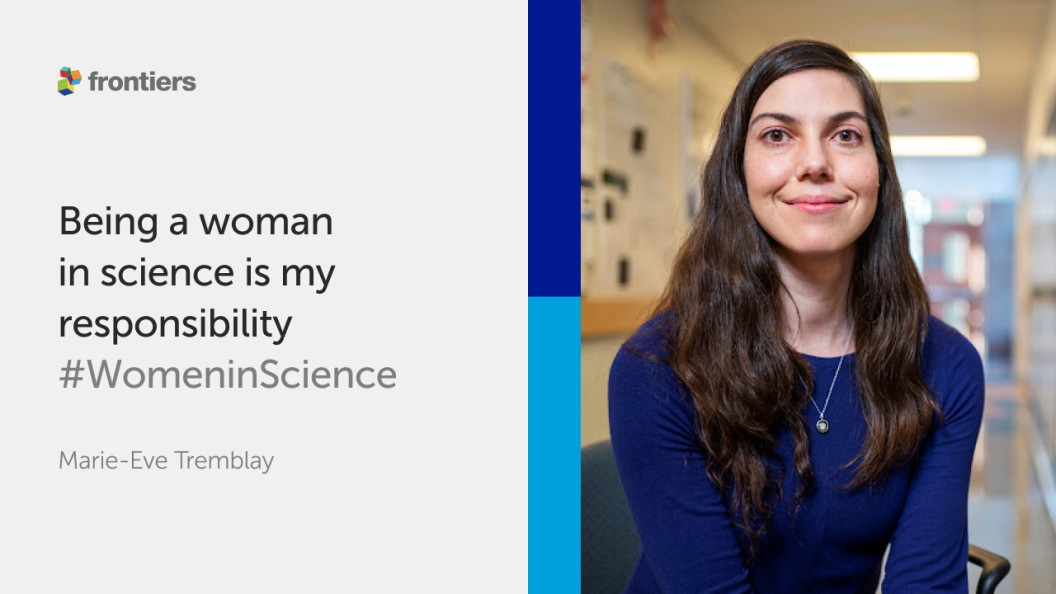- Science News
- Frontiers news
- Marie-Eve Tremblay – Being a woman in science is my responsibility
Marie-Eve Tremblay – Being a woman in science is my responsibility
Author: Leticia Nani Silva
Dr. Tremblay is an Associate Professor at the University of Victoria in Canada. She is a leading neuroscientist in her field and one of our Speciality Chief Editors for our journal Frontiers in Cellular Neuroscience with a specialty section of Non-neuronal Cells. In this blog post we discuss Dr. Tremblay’s career, but also how she maintains balance and an incredibly positive attitude that resonates within her research group and inspires her to achieve greater heights with her research into microglia.

As a Neuroscience-enthusiast and former student of the subject, it felt incredibly empowering to speak to a woman that works in this challenging field. I was curious to know how she has established herself as a pioneer within this area and also what it meant to be a woman working in neuroscience. I began by asking Dr. Tremblay how she has established herself within her field and where her love for the area came from.
“I think something that was really important was collaboration and establishing a network of contacts. I remember that I was a postdoc presenting my work in scientific meetings and I thought that it was so fascinating to match the faces of those in the room with the names I had read about in papers. I also remember that I always used to write the names down of people who used to visit my poster at scientific gatherings.
“For me, what really launched my career was when I organized scientific symposiums myself. I was shocked when the turnout was so much better than expected. I was so nervous and so shy to stand in front of people and talk about my work, but it allowed me to become more included within the network of pioneers within my field and to become more well-known. For my success, this network was key, especially when I started my own lab. I did not have grants or animals or equipment, but with the collaborators I had, I was able to establish myself really quickly,” Dr. Tremblay explains.
Dr. Tremblay tells us that her passion for neuroscience came from a very young age. She says that she has always loved biology and has always been fascinated with nature. She was curious about the brain and the nervous system, and how we learn new skills and how we adapt to different environments. Her work now focuses on microglia and their physiological role in the brain and how these roles can be disrupted in diseases. She comments on how, in the past, researchers were focused on killing microglia to prevent them becoming toxic, yet they did not realize that these cells could actually be beneficial.
The second part of the interview focused on what it means for Dr. Tremblay to be a woman in science. She gave the most beautiful and encouraging answer: she sees this as her responsibility to do more and to always do her best. She continues by saying how important it is to show women that it is possible to do this. Within her lab she has been promoting diversity and inclusion. She feels it is important to include women and help women make it in science. She comments on the fact that she was very lucky to have received so much support from women when she was starting out as a young scientist, that it is crucial to do the same for the up-and-coming generation.
For Dr. Tremblay, her children are a massive part of her motivation.
“I am also doing this for my children. It’s what gets me up in the morning and what makes me come to work with a smile on my face and motivate my team. I feel like I need to do my best and keep this up-and-coming generation interested in science. We need women, we need this diversity in order to be able to do good science.
”I really value balance in my life. I wake up early to meditate, read and write papers, and participate in meetings, so that I can prioritize my children in the afternoon. This balance should be better promoted in academia. When people feel their best, they can do their best at work as well.”
We then proceeded to speaking about her inspirations and her work today. Dr. Tremblay’s research has grown so much in the last few years, however, her curiosity has always remained the same.
“I got really interested in how I could manage my stress and eat well, and what lifestyle I wanted to adopt in order to have a sustainable future. This is also how I became more and more interested in studying environmental factors on microglia. I am, and will always be, inspired by life.
“The field of neuroscience is experiencing this exponential growth. So many discoveries are being made and so many new technologies being developed. Within the area of microglia, there is still so little that is known and this creates so many more opportunities to generate and answer new questions,” Dr. Tremblay says.
In concluding part of the interview we spoke about the words of wisdom Dr. Tremblay had to share with all those coming into the field of neuroscience and interested in becoming well-known within the realm of research. She advises to follow your passion and listen to your heart, and most importantly, find a topic that you want to study and make evolve for a long time. Be bold enough to reach out to other women in science and do not hesitate to ask for advice or mentorship.

Frontiers is a signatory of the United Nations Publishers COMPACT. This interview has been published in support of United Nations Sustainable Goal 5: Achieve gender equality and empower all women and girls.








